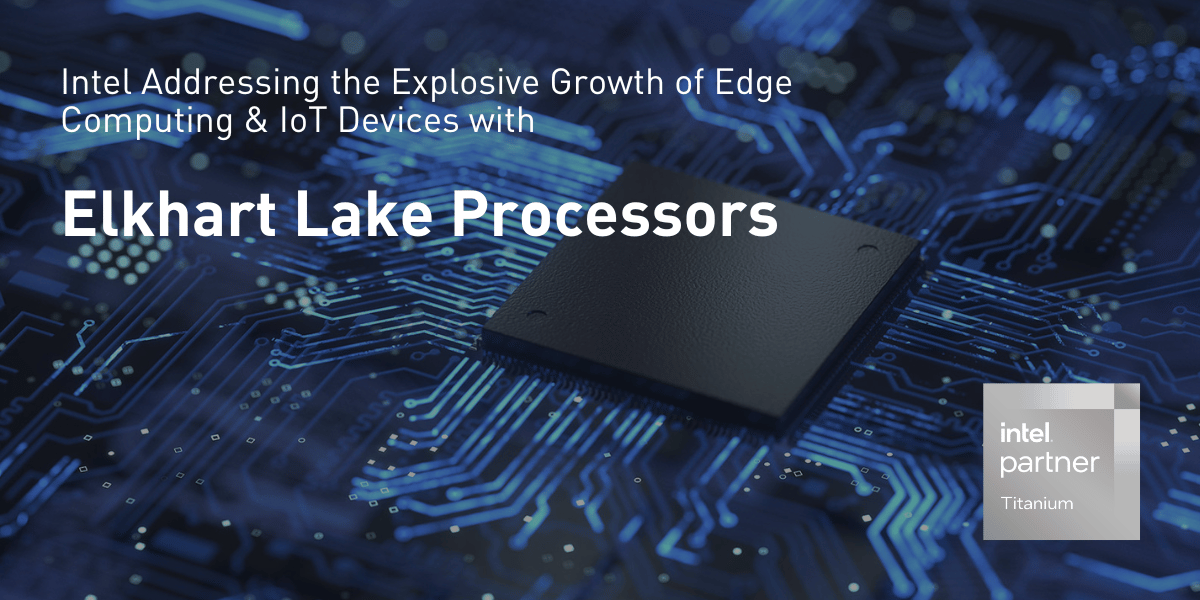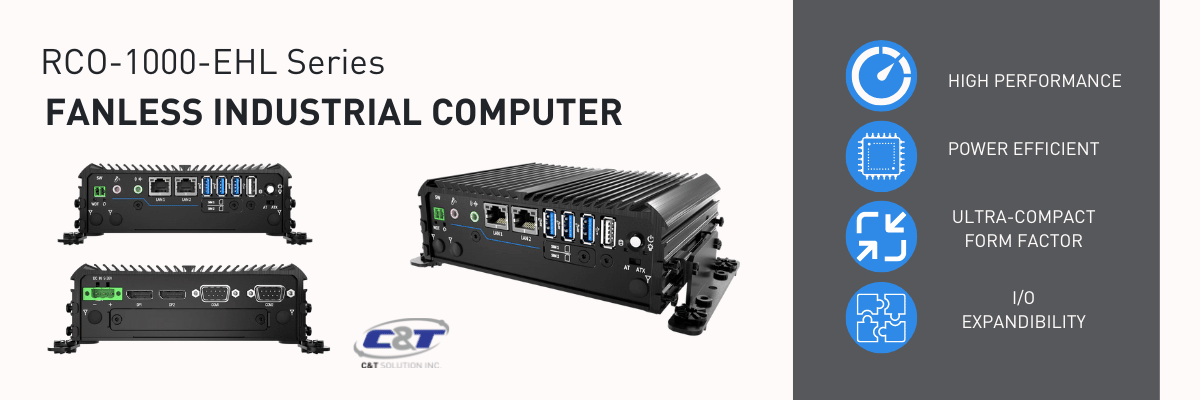What Is Intel Elkhart Lake Generation?

What is Elkhart Lake Generation?
As Industry 4.0 progresses, there's a growing need for processors that can handle increased performance demands while maintaining low power consumption, especially in edge computing and IoT applications. Traditional processors have struggled to meet these needs, leading to performance issues.
Intel's Elkhart Lake processors, including the Atom x6000 E Series, Pentium, and Celeron N & J Series, were developed to tackle these challenges. Designed for small, low-power devices, the Elkhart Lake family offers enhanced performance and ruggedization for the evolving demands of the embedded and industrial IoT sectors.
Elkhart Lake Applications
Elkhart Lake processors, are tailored for the industrial IoT sector. They deliver high performance with low power consumption, ideal for demanding conditions. Key deployment areas for these processors include environments requiring continuous uptime, operation in limited spaces, and resilience to physical stresses like shock, vibration, and fluctuating temperatures. Elkhart Lake is particularly suited for specific market segments where its IoT-optimized features can be fully utilized.
- Industrial & Factory Automation
- Retail Solutions
- Intelligent Kiosk Machines
- Smart IoT Infrastructure
- Medical Imaging & Diagnostics Solutions
- Vehicle Fleet Telematics & Management
What are advantages of Elkhart Lake? Comparison of Elkhart Lake vs Apollo Lake vs Bay Trail
While Apollo Lake (2016) and Bay Trail (2013) processors remain supported under Intel's 15-year product lifecycle, Elkhart Lake represents a modern evolution in the realm of low-power, high-performance processors for edge applications. This latest generation from Intel is specifically geared towards boosting edge computing capabilities and offering advanced solutions for IoT-centric applications.

1. Enhanced Performance Capabilities
The Elkhart Lake processors, including the Intel Atom x6000 E Series, Intel Pentium, and Intel Celeron N & J Series, offer a substantial performance upgrade compared to their predecessors. Utilizing a 10nm lithography (Tremont microarchitecture) for the compute die and a 14nm process for the Platform Control Hub (PCH), Elkhart Lake achieves a 1.7x increase in single-thread and a 1.5x increase in multi-thread performance over the earlier Apollo Lake generation.

The newest processors feature quad cores with burst frequencies reaching up to 3.0 GHz, yet they maintain impressively low Thermal Design Power (TDP) ranges between 4.5W and 12W. For edge applications demanding high-performance data processing with minimal power usage, this enhancement is vital for effective deployment.
| Elkhart Lake (Atom x6000E Series) |
Apollo Lake (Atom x5/x7 Series) |
Bay Trail (Atom E Series) |
|
|---|---|---|---|
| CPU Specifications | |||
| Lithography | 10 nm | 14 nm | 22 nm |
| Processor Base Frequency | Up to 2.00 GHz | Up to 1.60 GHz | Up to 1.90 GHz |
| Burst Frequency | Up to 3.00 GHz | Up to 2.00 GHz | - |
| L2 Cache | 1.5MB | 2MB | 2MB |
| TDP | Up to 12W | Up to 12W | Up to 10W |
| Memory Specifications | |||
| Max Memory Size | 32GB | 8GB | 8GB |
| Memory Type | LPDDR4 up to 3200MT/s | DDR3L up to 1866MT/s | DDR3L 1333 |
The Elkhart Lake series marks a significant improvement in RAM support compared to its predecessors. Earlier generations supported up to 8GB DDR3 L (1866MT/s) or LP DDR4 (2400MT/s), whereas Elkhart Lake supports up to 32GB LP DDR4 at speeds of up to 3200 MT/s. Notably, it features Intel In-Band Error Correction Code (IBECC) in select models. IBECC, compatible with standard non-ECC RAM, is crucial for mission-critical applications requiring high reliability and uptime. It's configurable in the UEFI, offering enhanced versatility and flexibility for OEM designers and system integrators.
2. Upgraded Graphics and Display
Elkhart Lake processors integrate Intel's Gen 11 UHD Graphics, achieving a 2x increase in graphics performance. This enhancement enables the processors to support three simultaneous 4K displays, making them ideal for digital signage, smart kiosks, IIoT & Robotics, and industrial or factory automation. Additionally, with up to 32 execution unit (EU) cores in specific models, these processors are well-suited for AI deep learning inference and computer vision applications, including medical imaging.
| Elkhart Lake | Apollo Lake | Bay Trail (RCO-1000-J1900) |
|
|---|---|---|---|
| Graphics Specifications | |||
| Processor Graphics | Intel UHD Graphics for 10th Gen Intel Processors | Intel HD Graphics 505 | Intel HD Graphics for Intel Atom Processor Z3700 Series |
| Execution Units (EU) | 32 | 18 | - |
| # of Displays Supported | 3 | 3 | 2 |
| Expansion Options | |||
| Integrated LAN | 3x 2.5GbE | - | - |
| PCI Express Revision | 3.0 | 2.0 | 2.0 |
| Max # of PCI Express Lanes | 8 | 6 | 4 |
| USB Revision | 2.0/3.0/3.1 | 2.0/3.0/3.1 | 2.0/3.0/3.1 |
3. Expansive Connectivity for IoT
The demand for connectivity in the expanding IoT landscape is met by this generation of low-power, high-performance processors, which offer comprehensive support for:
- 3x 2.5GbE LAN
- PCIe 3.0 (up to 8 lanes)
- USB 3.1 (up to 4 ports)
- USB 2.0 (up to 10 ports)
The latest processors enable system integrators and OEM designers to enhance real-time data analytics capabilities with 2.5GbE LAN support, a notable upgrade from the previous 1GbE LAN limit. This advancement is crucial as IoT data complexity increases, necessitating faster data transfer speeds. USB 3.1 integration offers a significant boost, with transfer rates of 10Gbps compared to USB 2.0's 480Mbps, benefiting IoT sensors and devices reliant on USB connections. Additionally, these improvements address the limitations faced by Industrial IoT applications in space-constrained environments, particularly the need for edge AI support.
The introduction of PCIe 3.0 enables more efficient edge AI workload management using various hardware accelerators. This enhancement allows industrial computers to support AI inferencing in applications like machine vision and smart kiosks more compactly. The processors now feature double the PCI Express Lanes and use PCIe 3.0, offering bandwidth speeds of 1GB/s per lane, a significant improvement over the 500MB/s of PCIe 2.0. This advancement in connectivity enables OEMs to facilitate real-time data processing in low-powered x86 architecture for critical edge applications.
4. Introducing Hardware-based Security (Intel PTT)
With the rise of rootkits and other malware, data security is crucial for industrial IoT devices, particularly in edge computing. Intel addresses this by integrating firmware-based TPM 2.0, known as Intel PTT (Platform Trust Technology), which encrypts and stores credential keys and prevents system boot in case of tampering. Additionally, Intel ensures robust security with protocols like Intel Boot Guard, Secure Key, AES New Instructions, and SHA Extensions, all reinforced by cryptography accelerators for enhanced overall performance and security.
Integrated IoT-Specific Features
Intel PSE (Programmable Service Engine)
Intel's Elkhart Lake now features the Intel PSE (Programmable Service Engine), an ARM-based dedicated offload engine. Powered by an Arm Cortex-M7 Microcontroller, Intel PSE enhances IoT applications by offering real-time capabilities like remote out-of-band device management, network proxy, embedded controller lite, and sensor hub functionality.
TCC (Time Coordinating Computing) & TSN (Time Sensitive Networking)
Integrating Intel TCC and TSN into the Intel Atom x6000RE and x6000FE processors significantly improves worst-case execution time (WCET) and ensures ultra-reliable low-latency communication (URLLC). This is crucial for latency-sensitive applications vulnerable to timing jitters, ensuring chronological accuracy. These technologies synchronize data across IoT networks, enabling more efficient real-time deployment. Moreover, TSN follows the IEEE 802.1 standard, offering a ready-to-use solution without licensing or royalty fees.
SI (Safety Island)
Exclusive to the Intel Atom x6000FE Series, Intel SI offers functional safety (FuSa) features that identify and mitigate system malfunctions to prevent or reduce further risks. These FuSa capabilities comply with international standards like IEC 61508 and ISO 13849, providing a globally trusted technology that helps organizations avoid lengthy recertification procedures. For instance, in the event of an automated device malfunction, FuSa intervenes to shut down the system promptly, preventing additional damage.
Remote OOB & INB Management
Elkhart Lake processors offer remote out-of-band (OOB) and in-band (INB) device management, enhancing remote usability even if the operating system becomes unresponsive. OOB management enables users to modify power states remotely, eliminating the need for physical presence. In contrast, INB management facilitates access to firmware and software updates. While some of these IoT-focused features are exclusive to specific Elkhart Lake models, they exemplify Intel's commitment to delivering high-performance computing in a low-power design, catering to the needs of IIoT and edge computing applications.
Specialty Intel Atom x6000E Series Processors
The x6000E Series is organized into three distinct tiers, each serving different applications. The Intel Celeron and Pentium N and J Series are designed for industrial edge computing integrations. On the other hand, the Intel Atom x6000E Series is tailored to offer specialized features like TCC and/or SI . For embedded systems, the Atom x6000FE processors are advantageous, especially with their TCC capabilities that enhance synchronization in latency-sensitive IoT deployments. Industrial systems primarily use the Atom x6000RE processors, which combine Intel TCC for precise timing and Intel SI for enhanced safety protocols, ensuring optimized management of IoT devices.
| Processor | Cores | Base Frequency | Burst Frequency | Base Graphics | Burst Graphics | TDP | TCC | SI |
|---|---|---|---|---|---|---|---|---|
| Atom x6000E Series | ||||||||
| x6211E | 2 | 1.3 GHz | 3.0 GHz | 350 MHz | 750 MHz | 6 W | - | - |
| x6413E | 4 | 1.5 GHz | 3.0 GHz | 500 MHz | 750 MHz | 9 W | - | - |
| x6425E | 4 | 2.0 GHz | 3.0 GHz | 500 MHz | 750 MHz | 12 W | - | - |
| Atom x6000RE Series | ||||||||
| 6212RE | 2 | 1.2GHz | - | 350MHz | - | 6W | Yes | - |
| x6414RE | 4 | 1.5GHz | - | 400MHz | - | 9W | Yes | - |
| x6425RE | 4 | 1.9GHz | - | 400MHz | - | 12W | Yes | - |
| Atom x6000FE Series | ||||||||
| x6427FE | 4 | 1.9GHz | - | 400MHz | - | 12W | Yes | Yes |
| x6200FE | 2 | 1.0GHz | - | - | - | 4.5W | Yes | Yes |
RCO-1000 Series Powered by Intel Elkhart Lake

The RCO-1000-EHL is a compact industrial computer powered by the Intel Elkhart Lake Celeron J6413, ideal for space-constrained IIoT applications requiring high-performance edge AI. This small-scale industrial computer is equipped with advanced AI accelerators, reflecting the combined expertise of Intel and C&T in computing performance, durability, and reliability for rugged edge environments.
- High-speed, IoT-specific I/O capabilities.
- Scalable Universal I/O with 1 to 5 Universal Expansion Slots.
- Dual External SIM Sockets supporting 5G/4G LTE, Wi-Fi 6, and Bluetooth 5.
- Wide Operating Temperature range from -40°C to 70°C.
- MIL-STD-810G Compliance for robust shock (50G) and vibration (5Grms) resistance.
- Certifications include UL, CE, and FCC Class A.


